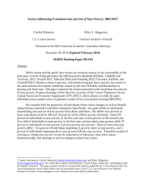Factors Influencing Transitions Into and Out of Near Poverty: 2004-2012
Factors Influencing Transitions Into and Out of Near Poverty: 2004-2012
Presented at the 2014 American Economic Association Meetings
December 20, 2013 (Updated February 2014)
Abstract
Media outlets and the public have shown an increased interest in the vulnerability of the near poor, or those living just above the official poverty threshold (DeParle, Gebeloff, and Tavernise, 2011; Dvorak 2012, Editorial; Short and Smeeding 2012; Tavernise, DeParle, and Gebeloff 2011). Similar to those in poverty, individuals living just above poverty face some of the same stresses of economic instability caused by job loss, ill health, and fluctuations in housing and food costs. This paper examines the factors associated with transitions into and out of near poverty. It takes advantage of the interview structure of the Current Population Survey Annual Social and Economic Supplement (CPS ASEC), which allows us to link the same individual across annual waves to generate a series of two-year panels covering 2004-2012.
We examine both the proportion of individuals whose status changes as well as identify characteristics associated with these transitions. Specifically, we report trends of individuals transitioning into and out of near poverty from above and below. We define near poverty as those individuals between 100 and 125 percent of the official poverty threshold. About 20 percent of individuals in near poverty in the first year stay in near poverty in the second year. Over half of individuals in near poverty in the first year exit into above near poverty while 27 percent of individuals in near poverty exit near poverty into poverty. Rates of entry into near poverty differ. Ten percent of individuals beginning in poverty move to near poverty, and 3 percent of individuals beginning above near poverty fall into near poverty. Transition models of entering or exiting near poverty reveal the importance of education, labor force status, homeownership, and marriage as well as changes in labor force status.
Others in Series
Working Paper
Working Paper
Working Paper




